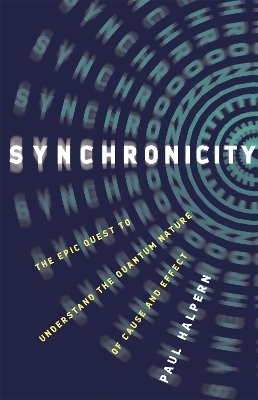
Synchronicity
The Epic Quest to Understand the Quantum Nature of Cause and Effect
Seiten
2020
Basic Books (Verlag)
978-1-5416-7363-2 (ISBN)
Basic Books (Verlag)
978-1-5416-7363-2 (ISBN)
From Aristotle's Physics to quantum teleportation, the story of the pursuit of causes that happen faster than the speed of light
In Synchronicity Paul Halpern tells the little-known story of the unlikely friendship between the Nobel-prize-winning quantum physicist Wolfgang Pauli and the father of psychoanalysis, Carl Jung. In the 1930s, Pauli and Jung began collaborating on a unified theory of quantum and the mind, the result of which was Jung's synchronicity principle-the idea that events connected by meaning need not be explained by causality. Pauli's work on entanglement theory, which allowed for instantaneous cause and effect relationships, was particularly appealing to Jung, as it seemed to give weight to his controversial theory of a collective unconscious.
Casting their relationship within a larger intellectual history of entanglement theory, Halpern poses a question that has mystified physicists and philosophers alike since the times of Aristotle: Is the speed of light finite, as Einstein posited, or is it, as Pauli and the proponents of entanglement theory asserted, variable across time and dimensions? As Halpern works his way through the history of the physics of cause and effect, he shows that this centuries-old debate is not only relevant at the smallest scales of particle physics but also at the largest scales of the cosmos itself.
In Synchronicity Paul Halpern tells the little-known story of the unlikely friendship between the Nobel-prize-winning quantum physicist Wolfgang Pauli and the father of psychoanalysis, Carl Jung. In the 1930s, Pauli and Jung began collaborating on a unified theory of quantum and the mind, the result of which was Jung's synchronicity principle-the idea that events connected by meaning need not be explained by causality. Pauli's work on entanglement theory, which allowed for instantaneous cause and effect relationships, was particularly appealing to Jung, as it seemed to give weight to his controversial theory of a collective unconscious.
Casting their relationship within a larger intellectual history of entanglement theory, Halpern poses a question that has mystified physicists and philosophers alike since the times of Aristotle: Is the speed of light finite, as Einstein posited, or is it, as Pauli and the proponents of entanglement theory asserted, variable across time and dimensions? As Halpern works his way through the history of the physics of cause and effect, he shows that this centuries-old debate is not only relevant at the smallest scales of particle physics but also at the largest scales of the cosmos itself.
Paul Halpern is a professor of physics at the University of the Sciences in Philadelphia and the author of sixteen popular science books, including The Quantum Labyrinth and Einstein's Dice and Schrödinger's Cat. He is the recipient of a Guggenheim fellowship and is a fellow of the American Physical Society. He lives near Philadelphia, Pennsylvania.
| Erscheinungsdatum | 21.08.2020 |
|---|---|
| Sprache | englisch |
| Maße | 154 x 234 mm |
| Gewicht | 520 g |
| Themenwelt | Naturwissenschaften ► Physik / Astronomie ► Quantenphysik |
| Naturwissenschaften ► Physik / Astronomie ► Relativitätstheorie | |
| ISBN-10 | 1-5416-7363-8 / 1541673638 |
| ISBN-13 | 978-1-5416-7363-2 / 9781541673632 |
| Zustand | Neuware |
| Haben Sie eine Frage zum Produkt? |
Mehr entdecken
aus dem Bereich
aus dem Bereich
Buch | Hardcover (2012)
Westermann Schulbuchverlag
CHF 44,90
Schulbuch Klassen 7/8 (G9)
Buch | Hardcover (2015)
Klett (Verlag)
CHF 29,90
Buch | Softcover (2004)
Cornelsen Verlag
CHF 23,90


